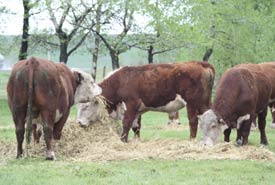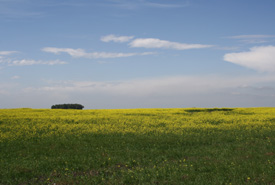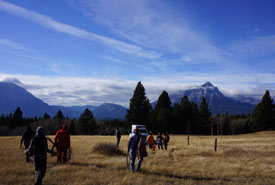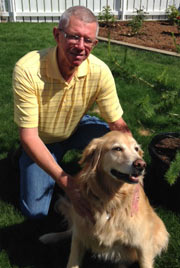Alberta's ranching evolution (Part Two)

A cattle herd just west of Fort MacLeod (Photo by Doug Madill)
(Continued from Part One.)
Since it was the landscape of the rangelands that had originally attracted me to Alberta and western Canada, I have become increasingly fascinated with not only the buildings and artifacts associated with the ranching life but also the people. Ranchers so often freely offer their time, hospitality and friendship. And that is what leaves a lasting impression.
In 1896, the federal government began to auction off the elaborate system of stock-watering reservations, which had been so freely offered to cattlemen before that time. The government, in its previous efforts to protect and grow the cattle industry, had set aside major rivers, creeks and springs as public stock-watering reserves.
The rush of homesteaders began in earnest. Coupled with a devastating winter in which there were no recorded chinooks (in the winter of 1906-1907), the cattle industry began to falter. Thousands of heads of cattle were lost to the climate and many of the large scale ranches were closed.
The loss was short lived, when in the 1930s, the "dirty thirties," drought-driven farmers were forced back to life in the city. It seemed that as long as the grazing of cattle was an efficient way of converting grass to protein, then ranching would prevail.
Towards a land ethic
In the early 1900s, Aldo Leopold, a Wisconsin conservationist and environmentalist, recognized the need for a land ethic addressing our human relationship to the land, the plants and the animals that grew on it.
In later years, agricultural and forestry organizations grew this notion of environmental stewardship to include a recognition of resilience-based ecosystem stewardship, which recognized the need for all ecosystems to be able to deal with global changes while still maintaining their basic structure and function. Resilience-based stewardship recognized the importance of habitat corridors connecting any species that had been separated by human activities.
More recent definitions have broadened the understanding of habitat corridors as components of the landscape that facilitate the movement of organisms and processes between areas of intact habitat. This new understanding clarifies that corridors may be species-specific, and may not only support the movement of biotic processes such as plant propagation, animal movement and genetic exchange but also abiotic processes, such as water and energy.

An agriculture field near Oldman River just west of Lethbridge (Photo by Doug Madill)
When we consider the history of Alberta’s ranching industry in relation to wildlife habitat corridors, we immediately recognize how the Alberta grazing leases from the 1880s to the present day have protected a vast tract of the rangeland that is now seen as critical to our natural ecological systems. Whereas intensive crop-based agriculture “gentlemen” farming has decreased wild grasslands to “tame” (non-native) crops, the cattle ranches of today are basically doing the same job that the roaming buffalo herds did hundreds of years ago. Alberta’s ranches may actually be the best option for the longer term sustainability of our grasslands, not only for cattle, but also for wildlife.
Bohomolec Ranch
The Nature Conservancy of Canada’s (NCC’s) Boholomec Ranch, a 314-acre (127-hectare) property, is located in the Crowsnest Pass near Coleman, Alberta. This stewardship project consists of two separate areas: Ranch 1 secured in 2008 and Ranch 2, secured in 2010. The two properties provide an important linkage to Crown lands in the north, and to the Crown of the Continent Ecosystem to the west.
The Crown of the Continent is a narrow section of the Rocky Mountains where Alberta, British Columbia and Montana meet. In global terms, it has the distinction of being one of the most intact, wild and diverse ecosystems in the temperate zone, supporting a biologically rich environment for 1,000 native plant species, 70 mammal species and 260 species of birds.
The Boholomec Ranch is part of a significant wildlife corridor across the Crowsnest Valley. It contains habitat critical for wintering elk, ungulate and grizzly bear populations. The Crowsnest Pass in itself spans 970 square kilometres of land along the Alberta-British Columbia border. It offers a spectacular transitional landscape where majestic mountains collide with the rolling rangelands.
Within the Boholomec property is found a geological event known as the Iron Ridge. The ridge provides users with increasingly sought-after education; it is an area of trees, grassy slopes and rocky cliffs, but is one of only seven volcanic sites in Canada where the rock was formed from a 425-metre-deep volcanic vent, somewhere just west of the present day Coleman townsite. The pillow lava specimens deposited here are similar to the lava flows being produced today on the Big Island of Hawaii..
In 2015, NCC Conservation Volunteers and staff removed 800 metres of fencing from the Boholomec that interfered with wildlife, primarily elk and deer, crossing the property. With the continued efforts of conservation organizations like NCC and ranch and rangeland managers, critical ecological functions such as water retention, carbon capture and plant and wildlife biodiversity can be maintained.

Boholomec Ranch, Crowsnest Pass (Photo by NCC)
Ranches such as the Boholomec, and the rangelands of Alberta and Saskatchewan, however, face a new threat. Just as Sir John A. MacDonald developed the Great Plains into 160-acre (65-hectare) parcels in 1881, today (1995 to present) landowners are looking to create rural residential country subdivisions and smaller lots out of wide open spaces. At some point, we will lose ecological functionality and aesthetic values, and wildlife will yet again succumb to habitat fragmentation and connectivity, if development is left unchecked.
To quote Aldo Leopold: ”We abuse land because we view it as a commodity belonging to us. When we see land as a community to which we belong, we may use it with love and respect.”
Stay tuned for Part Three of this blog, coming out on May 4, where I will discuss the implications of a human-altered range.


